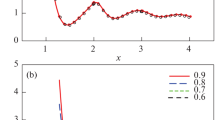Abstract
Possibilities of using various physicochemical models of polar liquids for describing the dielectric properties of model systems (one-, two-, or threedimensional dipolar hard spheres) are analyzed. Simple analytical formulas for the Kirkwood factor of the model systems are derived using the generalized hindered rotation model in a nearest neighbor interaction approximation. In the onedimensional case, an exact formula is obtained. For two- and three-dimensional spheres, the formulas adequately reproduce the available data of computer simulations over a wide range of thermodynamic parameters. In the lowtemperature limit (highly polar fluid), the expressions for the Kirkwood factor coincide with those in Pople’s bent hydrogen bond model. The associated equilibrium model also adequately describes the available experimental data in this limit, but leads to nonphysical results at high temperatures. The worst results are obtained in Wertheim’s mediumsphere approximation.
Similar content being viewed by others
References
E. S. Yakut, in:Reviews on the Thermal Properties of Substances [in Russian], Vol. 5, Institute of High Temperatures, USSR Academy of Sciences, Moscow (1983), pp. 38–99.
G. B. Litinskii,Teplofiz. Vys. Temp.,23, No. 5, 867–875 (1985).
G. B. Litinskii,Zh. Fiz. Khim.,70, No. 3, 392–398 (1996).
D. Levek, J.-J. Weiss, and J.-P. Ansen, in:Application of the Monte Carlo Method in Statistical Physics, K. Binder (ed.), Springer, Berlin (1982).
G. Stell, G. N. Patey, and J. C. Hoye,Adv. Chem. Phys.,48, 183–328 (1981).
I. R. Yukhnovskii and M. F. Golovko,Statistical Theory of Classical Equilibrium Systems [in Russian], Naukova Dumka, Kiev (1980).
V. A. Durov, in:Structure, Thermal Motion, and Properties of Liquids [in Russian], M. I. Shakhparonov and L. P. Filippov (eds.), Moscow State University, Moscow (1986), p. 35.
P. L. Brot,Ann. Phys.,2, 714–763 (1957).
R. H. Cole,J. Chem. Phys.,59, No. 3, 1545–1546 (1973).
J. A. Pople,Proc. R. Soc.,A205, 163–178 (1951).
V. V. Litinskaya and G. B. Litinskii, “Hindered rotation model for describing the dielectric properties of polar liquids”, Paper filed at UkrNIINTI No. 2656-Uk-87, 9.22.87, Kharkov (1987).
H. Fröhlich,Theory of Dielectrics;Dielectric Constants and Dielectric Loss, Clarendon Press, Oxford (1958).
A. D. Buckingham and C. G. Joslin,Mol. Phys.,40, No. 6, 1513–1516 (1980).
P. J. Flory,Statistical Mechanics of Chain Molecules, Interscience, New York (1969).
D. J. Adams,Mol. Phys.,40, No. 5, 1261–1271 (1980).
S. W. De Leuw, J. W. Perram, and E. R. Smith,Ann. Rev. Phys. Chem.,37, 245–270 (1986).
M. Newmann and O. Steinhauser,Chem. Phys. Lett.,95, 417–421 (1983).
C. G. Joslin,Mol. Phys.,42, No. 6, 1507–1518 (1981).
D. J. Isbister and B. C. Freasier,ibid.,43, No. 4, 799–815 (1981).
I. S. Gradshtein and I. M. Ryzhik,Tables of Integrals, Sums, Series, and Products [in Russian], Nauka, Moscow (1971).
G. P. Morriss and J. W. Perram,Physica,A129, No. 2, 395–407 (1985).
H. E. Stanley,Introduction to Phase Transitions and Critical Phenomena, Clarendon Press, Oxford (1971).
Author information
Authors and Affiliations
Additional information
Translated fromZhumal Struktumoi Khimii, Vol. 39, No. 5, pp. 843–850, September–October, 1998.
Rights and permissions
About this article
Cite this article
Litinskii, G.B. Kirkwood factor for dipolar hard sphere fluids. hindered rotation model. J Struct Chem 39, 687–693 (1998). https://doi.org/10.1007/BF02903541
Received:
Issue Date:
DOI: https://doi.org/10.1007/BF02903541




